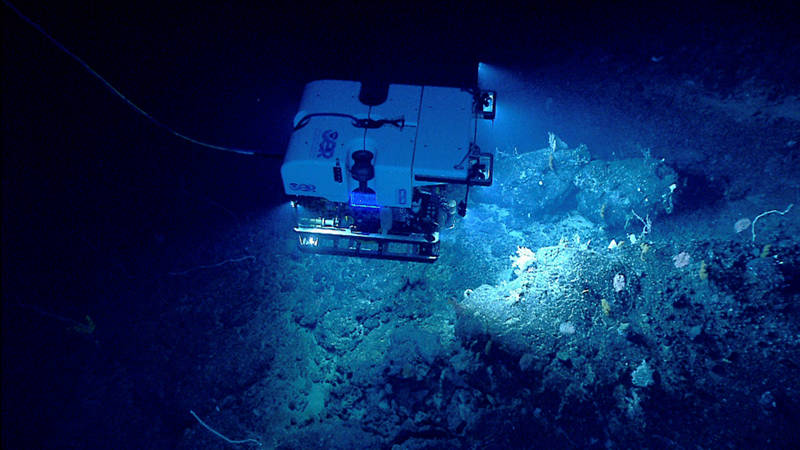
ROV Deep Discoverer investigates a diverse deep sea coral habitat on Retriever Seamount. Image courtesy of NOAA Okeanos Explorer Program, Our Deepwater Backyard: Exploring Atlantic Canyons and Seamounts 2014. Download larger version (jpg, 1.6 MB).

ROV Deep Discoverer investigates a diverse deep sea coral habitat on Retriever Seamount. Image courtesy of NOAA Okeanos Explorer Program, Our Deepwater Backyard: Exploring Atlantic Canyons and Seamounts 2014. Download larger version (jpg, 1.6 MB).
Okeanos Explorer EX1404L3
Dive 5 – Retriever Seamount. Video courtesy of NOAA Office of Ocean Exploration and Research. Download (mp4, 57.4 MB)
We had a fantastic dive today on Retriever Seamount! We encountered the highest coral diversity we have seen yet, and surprisingly low numbers of fish. Remotely operated vehicle Deep Discoverer (D2) descended on a pebble strewn sandy bottom with several brittle stars at a depth of approximately 2,140 meters. As D2 transited upslope, we encountered several sea pens, xenophyophores (giant unicellular organisms), occasional cup corals, and a multitude of brittle stars. During our transit, the sediment depth was tested with the “Sepoke” and was found to be greater than 50 centimeters. Throughout the dive, the areas of highest faunal diversity were occasionally manganese-encrusted boulders or rock outcrops that had corals, sponges, and anemones. Other fauna seen during the dive included a few rare sea stars, a couple vagrants of sea urchins (we learned during the dive that a large group of urchins is a "vagrant"), polychaete worms, both king and red crabs, squat lobsters, halosaurs, eels, a chimera, a slickhead, crinoids, and hydrozoans. The highlight of the dive was a large outcrop with a high diversity of corals that included stony corals, octocorals, precious corals, black corals, and bamboo corals. Several of these colonies were juveniles, showing that this in an area of active coral recruitment.